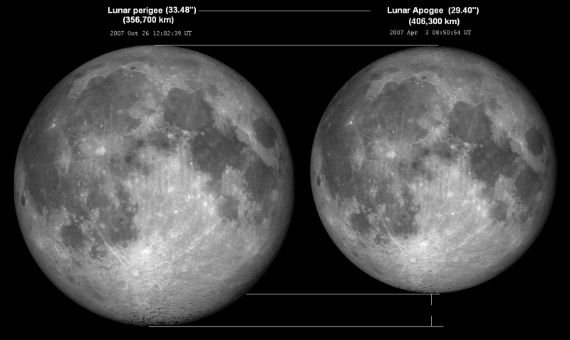The prefix “super” is not uncommon in science. In physics we have superconductors, supersymmetry or the hadron supercollider; meteorologists talk about supercells and astronomers seem to be especially prone: they study supernovae, superclusters, super-Earths and… these days one of the most popular “supers” of recent years is back in the news: the supermoon.
The Moon is not always the same distance from Earth. Sometimes it’s a little closer and sometimes a little further away, because the satellite doesn’t go around the planet in a perfect circle: the Moon’s orbit has another geometric shape known as an ellipse, something like a flattened circle. This means that as it travels along this path, its distance from us varies, ranging from the perigee (peri means near and geo means Earth) —which is the point in the orbit where it is closest to the Earth, about 356,000 kilometres— to the apogee (apo means far) —the point of maximum separation, some 407,000 kilometres from us.
On the other hand, the phases of the Moon are not coordinated with this orbital path, and therefore do not always happen at the same distance from the Earth. One month the full moon may coincide with the perigee, another month with the apogee, and another month at an intermediate distance. When the full moon occurs near the perigee (the period when it is closest to the Earth), the lunar disk can be seen to be slightly larger and brighter, giving rise to the popular term supermoon.
How super is it really?
With the largest of the supermoons, when the satellite is at the shortest distance from the Earth, the lunar disk is 6% larger than an average full moon and 14% larger than the micromoon —which is the opposite phenomenon, when it is at its apogee and therefore looks smaller.

The use of the prefix super is usually justified in other scientific jargon: a supernova is one of the most violent phenomena in the universe, and a superconductor is a very exotic material that seems to defy the laws of physics. But in the case of the supermoon, the term is much debated, even within the scientific community itself. Science populariser and astrophysicist Neil DeGrasse Tyson reframed it like this: if instead of referring to the Moon, we think of a pizza, that 6% difference in size is equivalent to the difference between a normal 15-inch pizza and a 16-inch one. Is that really enough of a difference to talk about a superpizza?
What’s more, if we could observe a supermoon and a micromoon in the sky together, side by side, sharp-eyed observers might be able to differentiate the supermoon. But even then, it wouldn’t be that easy, and it’s not what actually happens. To compare full moons you have to wait one month for the next one, which makes it a difficult task. While it is possible to make such a comparison photographically, when viewing the sky with the naked eye it is very tough to notice the size difference of the Moon from month to month. Only the most experienced observers are able to discern it.
The lunar illusion trick returns
However, every time the supermoon makes the news, a multitude of testimonies are repeated from all over the world, sent by people who believe they have seen a Moon that is much larger than usual. This is mainly due to the so-called lunar illusion, which is just an optical effect. When the Moon is close to the horizon it always appears to us to be much larger —if other smaller objects, such as trees and buildings, appear close to it— than when the Moon is higher in the sky. But if one day we photograph the Moon near the horizon and, hours later, high in the sky, we will see that its angular size is the same, despite appearances.
When the Moon is in its full phase, it always rises just as the Sun sets, travels across the sky all night and sets at sunrise. That is why supermoons —which are full moons— are always close to the horizon at dusk, which is the most common time to go out and observe them. Thus, the lunar illusion effect makes the lunar disk appear much larger than the actual 6%.
A frequent celestial show
If we review the full moon data, we can see that several supermoons and also some micromoons can be observed each year. These are not rare phenomena, and it is also common for several to be repeated in a row:
Supermoons in 2020…
9 March: 357,404km
8 April: 357,035km
7 May: 361,184km
Normal or average full moon 2020
5 July: 381,757km
Micromoons 2020
3 October: 405,425km
30 October: 403,452km
Regardless of the phase, we must remember that the observation of the Moon is one of the best sights in the sky. To the naked eye, the full moon is spectacular, especially when rising over the horizon and taking advantage of the moon illusion.

A pair of binoculars can come in handy for observing details on the Moon. With a telescope, strange as it may seem, the full moon may not be the best phase for observation; when the Sun’s rays fall perpendicularly, as in that phase, the Moon looks like a flat photo, without relief. Telescope observation is much more spectacular during the quarter phases, when the shadows of the craters and mountains can be seen, especially at the terminator, the line that separates the light and dark areas on the lunar disk.
The term supermoon might best be thought of as some sort of astronomical clickbait, a trick to generate interest in observing the sky, although there is little of substance behind this “super” label. But unlike journalistic clickbait, its worth is beyond doubt: it is one of the best reminders of a celestial spectacle of singular beauty that is within our reach each month.
Comments on this publication